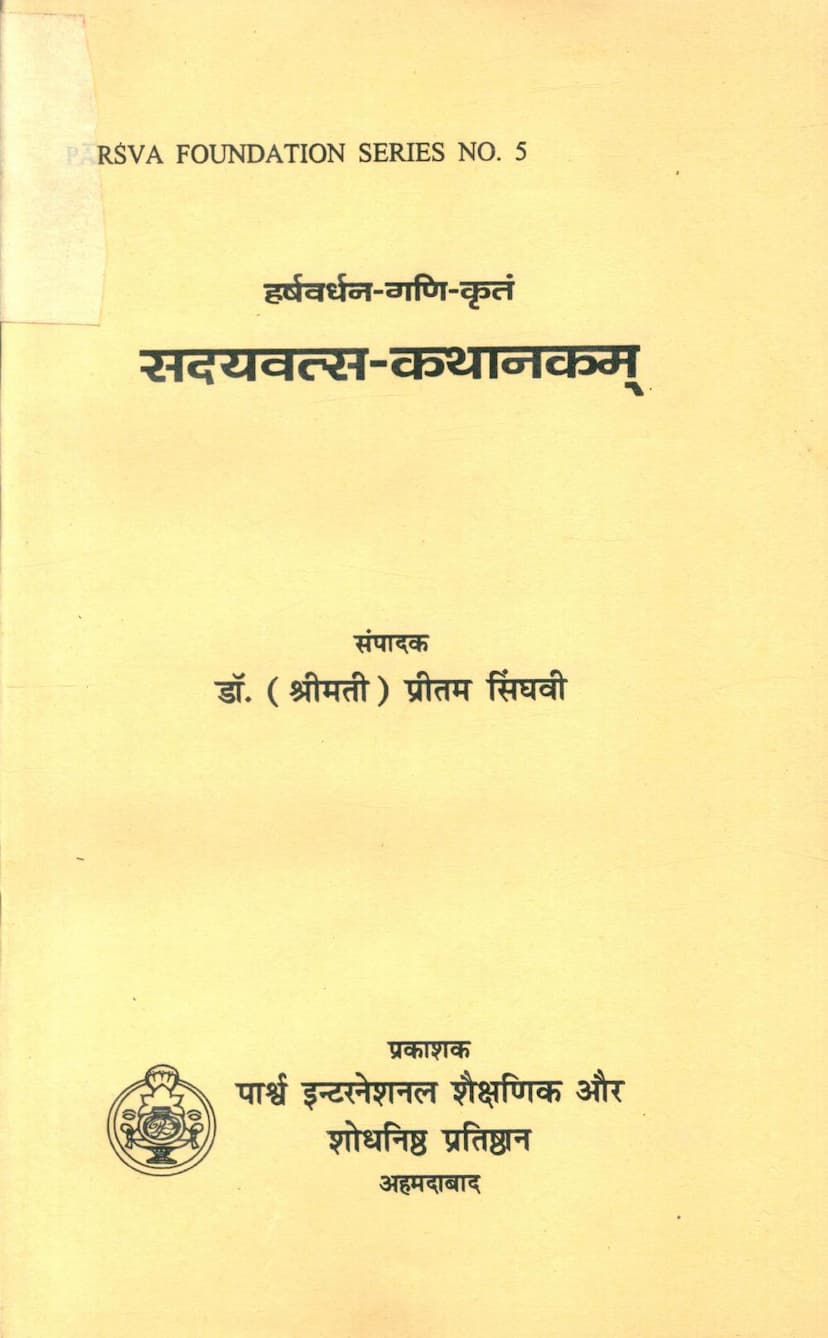Sadyavatsa Kathanakam
Added to library: September 2, 2025

Summary
This Jain text, titled Sadyavatsa Kathanakam (सदयवत्स कथानकम्), is a work by Harshvardhan-gami (हर्षवर्धन-गणि), edited by Dr. Pritam Singhvi (डॉ. (श्रीमती) प्रीतम सिंघवी). It was published in 1999 by Parshwa International Educational and Research Foundation (पार्श्व इन्टरनेशनल शैक्षणिक और शोधनिष्ठ प्रतिष्ठान) in Ahmedabad, as part of the "Parsva Foundation Series No. 5".
The book is presented as a foundational text in Jainism, with a focus on the story of Sadayvatsa. The editor, Dr. Pritam Singhvi, explains in her introduction that the first published version of "Sadayavatsa Charitra" was in 1853, but its authenticity is questionable due to alterations made by the editor of that edition. The current edition is based on a manuscript from the Jaisalmer archive, dating back to V.S. 1528 (1471 AD), which was prepared under the supervision of Muni Jinavijaya. Dr. Singhvi expresses her gratitude to H.C. Bhayani for his guidance and to the Parsva Foundation for publishing the work.
The core of the text narrates the life and adventures of Sadayvatsa, a prince from Ujjayini, son of King Prabhuvatsa and Queen Mahalakshmi. The story highlights the importance of Dharma (righteousness), particularly Dana (charity), as a means to attain liberation.
Key elements of the narrative include:
- Sadayvatsa's character: He is depicted as virtuous, courageous, and liberal, but also prone to gambling in his youth.
- His exile: Due to the machinations of a minister who feared losing favor, Sadayvatsa is banished from his kingdom along with his wife, Savalingi.
- Trials and tribulations: During their exile, they face numerous hardships, including thirst in a desert where Sadayvatsa offers his own blood to save his wife, a test orchestrated by the goddess Harisiddhi.
- Divine intervention and magical aids: Harisiddhi, pleased with Sadayvatsa's resilience, gifts him magical dice, cowries, and a knife, making him invincible in gambling and battles.
- Encounters and relationships: Sadayvatsa meets and marries Lilavati, daughter of King Dharavira of Dharā, while still in exile. He also encounters various characters like thieves, merchants, courtesans (Kamasena), and kings in different regions.
- Adventures and heroism: The story is filled with adventurous episodes, including rescuing a pregnant Brahmin woman from a mad elephant, battling enemies, outwitting thieves, resolving disputes, and even facing supernatural entities like demons and witches.
- Moral lessons: The narrative underscores the value of righteousness, courage, loyalty, the dangers of gambling and addiction, and the consequences of actions driven by greed or malice. It also emphasizes the importance of friendship and mutual support.
- The role of fate and karma: The text often refers to past karma as a driving force behind current circumstances, influencing fortunes and misfortunes.
- The return and ultimate triumph: After many adventures, Sadayvatsa is eventually recognized by his father and reinstated as the heir apparent. He reconciles with his father and ultimately ascends the throne, ruling justly and promoting Dharma.
- Subordinate narratives: The text includes several embedded stories, such as the tale of Mriganka and Padmavati, and the story of the rescued princes and the witch, to illustrate specific moral points or add to the richness of the narrative.
The text is written in a scholarly manner, with extensive quotations and references to other works, aiming to preserve and present an authentic version of the Sadayvatsa legend for academic and personal study within the Jain tradition. The inclusion of the "Katha-saar" (Story Summary) in Hindi at the end provides a concise overview of the main plot points.